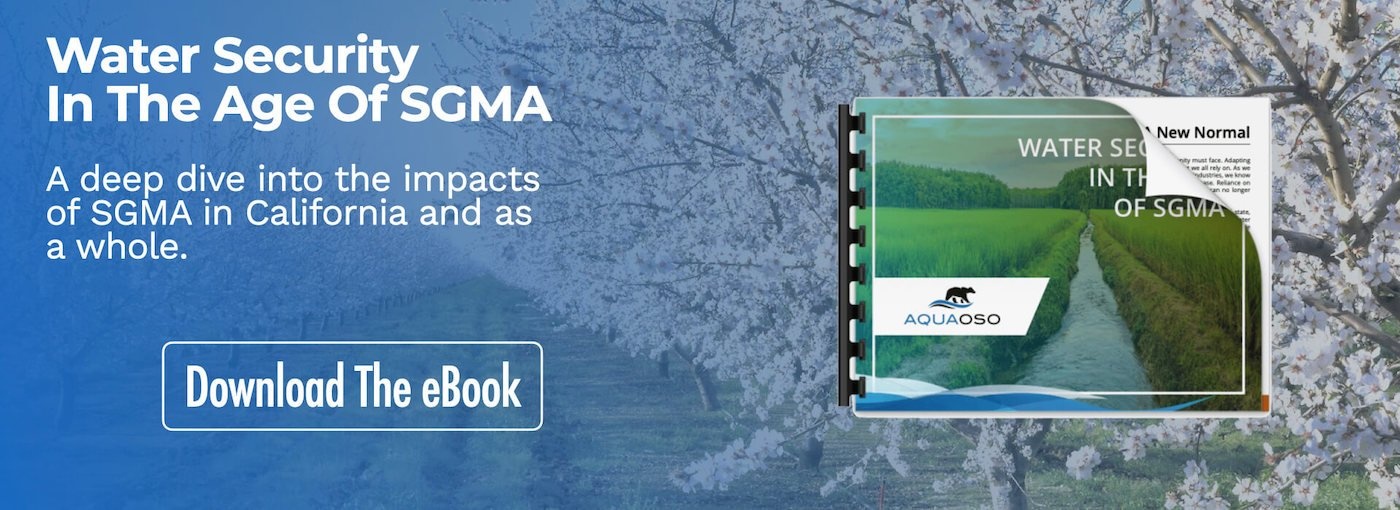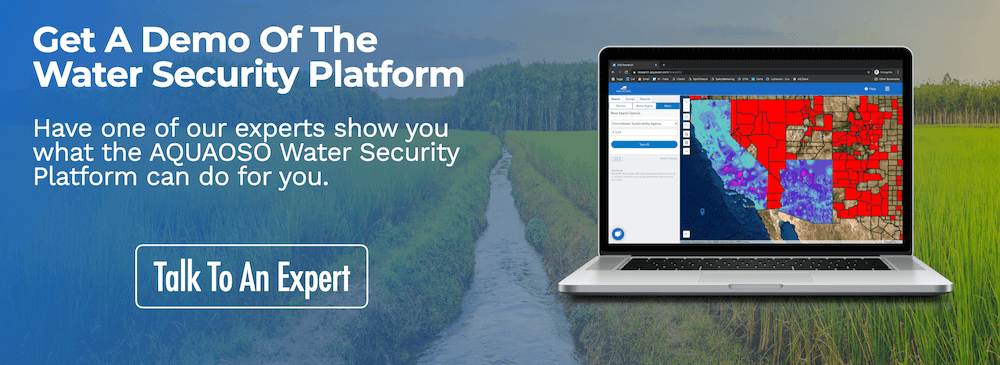Future Methods of Conserving Water in Agriculture

Part of our How to Conserve Water in Agriculture Guide
Water stress is projected to reach unprecedented levels in the American Southwest by 2030. Since 90% of the U.S. West’s water is used by agriculture, methods of conserving water in agriculture are key to ensuring sufficient water resources for both rural and urban areas. States like California, Colorado, and Arizona, are already negotiating how to make use of the diminishing water resources in the Colorado River.
While some countries, such as Israel, have found ways to produce usable freshwater from Mediterranean seawater, the U.S. hasn’t yet managed to put desalination plants into action. For now, water conservation still remains the most effective approach for reducing water stress across many regions and industries.
“With at least 40 states anticipating water shortages by 2024, the need to conserve water is critical.” (U.S. EPA)
In this post, we’ll take a look at methods of conserving water in agriculture and how new technologies, increased regulations, and other factors are going to impact water conservation in agriculture in the near future.
Increased Regulations
Water conservation regulations vary from state to state and encompass everything from plumbing regulations to drought contingency plans. According to a Water Efficiency and Conservation State Scorecard published in 2017, only 11 states achieved an A or B for both conservation and climate resiliency, with California topping the list.
Here’s a look at some of the regulations that are likely to impact water conservation in agriculture in the near future:
SGMA
The Sustainable Groundwater Management Act was signed into law in 2014, making California the last state to regulate groundwater. SGMA empowers local Groundwater Sustainability Agencies, or GSAs, to oversee groundwater usage in their basin.
Aimed at addressing the depletion and degradation of groundwater resources, SGMA is especially relevant to farmers, who will be required to measure, and in many cases limit, the amount of groundwater they can use to water their crops.
With Groundwater Sustainability Plans (GSPs) coming into effect in 2020 and 2022, we can expect to see a major impact on conservation practices in the region, as well as the rise of smart water markets to facilitate groundwater trading.
Colorado River Compact
The Colorado River Compact was originally signed in 1922 to address the allocation of water resources in the Colorado River basin. With water levels in Lake Mead and Lake Powell at their lowest levels in decades, the seven affected states – Arizona, California, Colorado, Nevada, New Mexico, Utah, and Wyoming – agreed to make voluntary cuts that will preempt mandatory restrictions imposed by the federal government.
Since this is only a stopgap measure, a new deal will have to be struck by 2026, and it remains to be seen what long-term effects it will have on agriculture in the region.
Arizona already has earmarked $9 million to support farmers in Pinal County, who will be forced to drill new groundwater wells in order to offset the reductions.
New Technologies to Uphold Regulations
With new regulations on the way, how can farmers and investors meet their obligations without getting bogged down in red tape and paperwork? One possibility is to leverage the power of new technologies to streamline data collection and compliance.
IoT Water Sensors
Many homeowners have embraced IoT (Internet of Things) technology to improve water and energy conservation in the home. From smart lights to smart refrigerators, it’s easy to monitor and adjust energy consumption from a centralized dashboard.
While some farmers are reluctant to share their well use data with regulators, using IoT technology is an efficient way to demonstrate compliance and avoid overpumping.
Not only that, but smart water sensors can be used to monitor other variables as well, including pH level, salinity, and additional factors that impact crop health.
Remote Sensing Technology
IoT-connected well meters aren’t the only way to monitor groundwater resources. Radio waves, electric currents, and even satellites have all been used to determine how much groundwater is available in a given region.
One approach, called the METRIC technique, uses “evapotranspiration” to “retroactively determine water use from historical images.” In another project, “a pair of twin satellites launched by NASA were able to estimate that Central Valley aquifers had (just between 2003 and 2010) lost 25 million acre-feet of groundwater.”
These approaches can help measure something that groundwater meters don’t cover: recharge, or the amount of water that returns to an aquifer after pumping. With better data, regulators can uphold pumping restrictions while also working with farmers to conserve and replenish scarce groundwater resources.
Better Methods of Conserving Water in Agriculture
Regulations aside, new technologies and farming practices can help improve water use efficiency for its own sake. From more efficient irrigation to indoor farming, here are just a few ways that water conservation in agriculture is going to change in the future:
Improved Irrigation
Traditional farming practices rely on manual measurement of key metrics, such as soil humidity, soil temperature, and more. Not only is this a time-consuming process, but it can lead to overwatering or underwatering if the measurements are off.
New IoT technologies can track all of these variables in real-time for more accurate – and actionable – data. According to IBM, these systems can help reduce waste and improve crop output by making use of both soil and environmental sensors.
They can even take weather forecasts into account so farmers can “build advanced irrigation systems to save water and prevent pesticide waste by predicting rain.”
Reduced Evaporation
Another key driver of water waste is evaporation, especially when fields are left fallow for long periods: “Soils fallowed for a 21-month period (from harvest to spring of crop year) can be expected to lose three-fourths of the precipitation received.”
In California, SGMA is expected to lead to the retirement of as many as 1 million acres of land in the San Joaquin Valley alone, while in Arizona, a drought could lead farmers to leave up to 40% of their lands fallow for extended periods.
Maintenance practices, such as covering fields in light-colored soil to reflect sunlight or using wheat-grass strips to prevent wind, can help reduce water loss. Other techniques include reducing tillage and maintaining crop residue on the surface of the soil.
Indoor Farming
While indoor farming is well-established in some parts of the world, especially in Japan and the Netherlands, it’s still an underdeveloped market in the U.S.
Many indoor farms rely on vertical farming to maximize the available growing space; controlled-environment agriculture (CEA) to create year-round growing conditions, and soil-free hydroponics to reduce evaporation and improve nutrient transfer.
Some examples of indoor farms in the U.S. include:
- AeroFarms, which grows microgreens in New Jersey under LED lights and uses “95% less water than conventional agriculture on just one percent of the land required.
- Bowery Farming, which produces leafy greens and herbs in New Jersey and Maryland. It uses BoweryOS, its proprietary farm operating system that relies on “computer vision, automation, and machine learning to monitor our crops and all the variables that drive their growth,” and allowing them to track the entire process “from seed to store.”
- Square Roots creates indoor farms in shipping containers that it claims can replicate any climate based on historical data. Because of their small size and portability, these farms are primarily intended for use in crowded urban environments.
Smart Tractors and Drones
You don’t have to farm indoors in order to make use of the latest agricultural technology. John Deere has been rolling out smart tractors as part of their precision agriculture line that can help people improve tillage, seed placement, irrigation, and more.
These include touch-screen displays, satellite receivers that can pinpoint location to within an inch, and AutoTrac hands-free guidance systems.
In Australia, scientists are developing smart drones that will allow farmers to “plan and deliver precise water and nutrients to their crops on a need-by-need basis.”
You can learn more about how to conserve water in agriculture and why it matters in our comprehensive guide.
The Bottom Line
Many of the methods of conserving water in agriculture that we’ve looked at come down to one central and very important thing: data
While we can’t claim to predict the future, we do know a bit about how to aggregate useful water data for farmers, lenders, and investors.
You can learn more about the regions we serve or reach out to our team to request a demo and find out if our platform is right for you!


